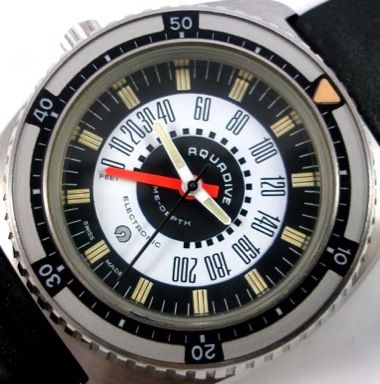
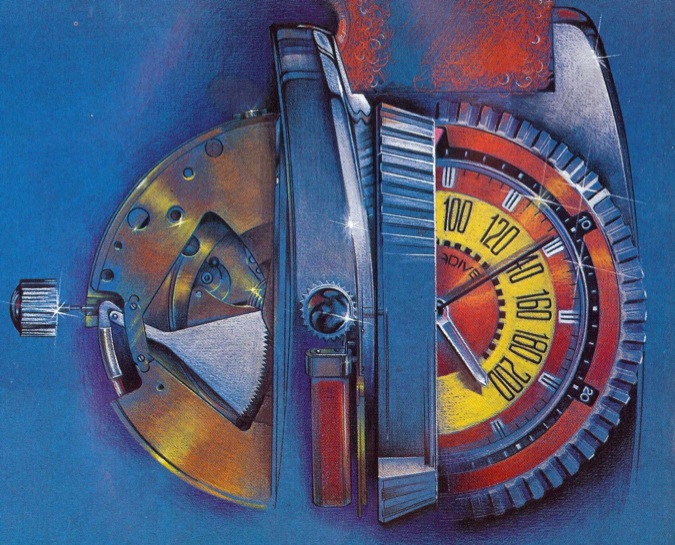




On April 16th 1968 a US patent was filed for an invention to measure water depth on the dial of a wrist-watch. The invention used a mechanical system to take the pressure from the water surrounding the watch, using hydraulic fluid and gears to transfer that measurement to a concentric pointer to indicate depth. The patent was registered on behalf of the Aquadive watch company and this patent would manifest itself as one of the coolest (and also one of the largest) dive watches of the 1970’s.
Interestingly, when the watch was originally introduced its Bourdon tube contained a type of hydraulic oil that was hygroscopic. Obviously that was not ideal in a dive watch and all the early examples had to be returned to the manufacturer as water absorption caused the depth needle to no longer point correctly to the zero mark, rendering the gauge un-trustworthy (therefore unsafe) for diving. The oil was replaced with a new type of fluid known as ‘Fyrquel’, a fire resistant hydraulic fluid and lubricant, which most importantly resists moisture absorption.
All content copyright DeskDivers 2011
No photograph or text from this article can be reproduced without prior permission from DeskDivers. As such all text on this page is protected by enforceable copyright.
Regarding the pictures on this page - DeskDivers either owns the rights to these pictures, has permission to use these pictures or has taken every step possible to contact the owner of any borrowed pictures – As such all pictures on this page are protected by enforceable copyright.
A working depth gauge is a bonus rather than a given, many have ruptured membranes or seals and some have problems caused by watchmakers removing the wrong screws when uncasing the movement.
Due to the oil filling in these watches the depth gauge is not readily repairable by watchmakers, although automotive gauge restorers may have the knowledge to effect a repair but to our knowledge that route is yet untested.
Considering their use as tools of the trade for divers these watches are often found in a parlous state today, having been utilised as intended. After a full term of use, it seems that as dive computers came onto the market many dive watches were treated like ‘just another bit of old kit’ and being no longer required as safety kit, were often stored in less than ideal conditions. Whilst today these damaged watches are not usually something many watchmakers would be prepared to try and restore, especially factoring in their electronic movement and hydraulic depth gauge in the mix. DeskDivers took pity on one of our friends and offered to have a go at fixing his sorry looking example, what followed was not for the faint hearted! If you want to see what it takes to bring one these watches back from the brink, then click here for the full story.










Sold from 1973 onwards and available under either the Aquadive brand as the ‘Model 50’, and more rarely under the Rotary name, it made a bold statement with its bright colours and unique depth gauge feature. The Aquadive and Rotary models differ in many ways, not least in the hands and the scale of the depth meter.
The Model 50 is powered by an electronic movement supplied by ESA and is badged with the ‘NAC inc’ brand on the battery cover. For those unfamiliar with the movement technology in this watch, the ESA 1954 is not quartz or a tuning fork. Instead this is an electronic movement that draws power from a battery and uses it to energise a balance wheel, in the same manner as the stored energy of the mainspring does in a purely mechanical watch.
The ‘Pièce de résistance’ of this watch is its depth gauge, which is mechanical and works using a Bourdon tube. This device is an oil-filled curved brass tube that has a membrane in a sleeved orifice between the lugs at 12 o’clock.
The case back inscription is quite verbose, and reads:
COMBINATION ELECTRONIC WATCH. OIL FILLED DEPTH GAUGE, DEPTH TESTED TO 10 ATM, INCABLOC, ANTIMAGNETIC, STAINLESS STEEL, SWISS
Often these have a ‘unique number’. The Aquadive version of the watch also has ‘US Patent No.337 78 60’, Rotary versions do not and the text has been milled from the case back. Both have the central NAC shield.
The acrylic unidirectional bezel is superbly executed and very solid to turn, adding to the feeling that this watch is truly a class act. It stands slightly proud of the mineral crystal and this type of ‘sacrificial bezel’ design was used to protect the watch glass from impact at depth, damage that could potentially flood the watch and render it useless as a dive instrument. Like the hands, the bezel’s zero marker is filled with tritium luminous material and like the markers it has a glorious 3D aspect when viewed with a loupe.
The Aquadive Model 50 is occasionally erroneously attributed to USN (United States Navy), UDT (Underwater Demolition Team), Navy Seal and other military diving establishments, yet so far no proof has been found that these watches were ever issued (if anyone reading this has information to the contrary to this, please contact DeskDivers so we can set the record straight). The watch does have a lot of specifications that would be attractive in that line of work, particularly its antimagnetic properties, and it could be the myriad of numbers on the back of the case that lead people to think that these watches were military issued.
It’s no secret that compared to other watches of the era, the Model 50 is huge and also very heavy.
When new, this watch would have been jaw dropping on first acquaintance for most potential buyers, yet they would perhaps have been swayed by the fact they had two instruments-in-one and they could now leave their old bulky depth meter at home when diving.
Today the fashion is for larger watches, and whilst these are no lightweights, they are comfortable to wear on quality retro bracelets such as the Omega mesh.
Whilst the Skin Diver review (published in their September 1975 issue) suggests that the watch was originally supplied on a bracelet with an expanding clasp and a locking mechanism. That description reads similar the type of clasp used on Doxa watches of the era, DeskDivers has yet to see one of these bracelets so if you have one please let us know. The same review also makes mention that included in the package with the watch was a ‘Neoprene’ strap. Occasionally watches are found with these original plastic straps still fitted.
DeskDiver fans might prick up their ears when we mention Neoprene, sadly the reality isn’t quite as cool as it sounds. These straps taper dramatically from 24mm at the watch head to a skinny unsigned buckle. DeskDivers would call this strap material ‘plastic’ as it is much more solid than what we think of as Neoprene today, and is more akin to the Tropic brand of straps than the coveted Isofrane material. Whilst the original plastic strap (with No. 6924 and 24mm cast into the plastic at the lugs) does not really work due to this taper it was probably chosen to further enhance wrist articulation when diving, but does make the watch feel top heavy if worn in this manner.
Specifications:
• Stainless Steel case
• Uni-directional Stainless Steel 60 click bezel
• Tritium luminescent hands, hour markers and bezel
• Mineral glass
• Crown – screw down with o-ring
• Electronic ESA 1954 movement with 13 jewels
• Water resistant to 100 meters (330 ft.)
• Depth Measurement to 60 meters (200 ft.)
• Width: 46mm
• Width: 51mm including crown
• Length: 53mm
• Weight: 125g (head only)
• Thickness: 18mm
• Crystal/Dial width: 32.4mm
• Bezel width: 45.5mm
• Lug width: 24mm



At the time the Aquadive brand was owned by N.A.C Sales (Cal) Inc., based in Los Angeles, California. The relatively new brand already had experience of producing a range of proper dive watches that were available through dive shops. Many of the watches in the range used watch case designs shared with other manufacturers and Aquadive stated in their advertisements that their watches were ‘Created by experts – For experts’ and also maintained that they were tested to the stated depths.
Sadly, the Aquadive brand was one of the many casualties of the quartz revolution. Its demise was a real shame for those who enjoy dive watches as the brand produced a number of very cool watches aimed specifically at those who like to get wet. The brand has recently been relaunched with the first new models being based on the ’50 case shape.

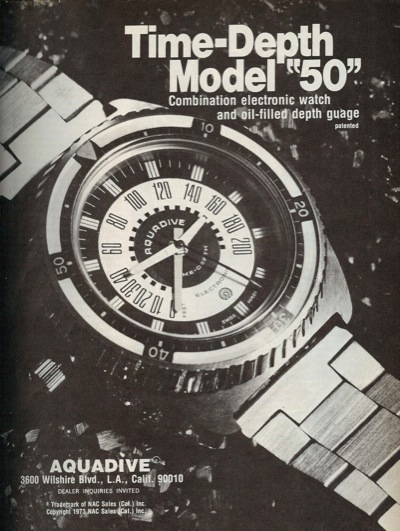

Whilst no records exist of the production numbers or its timeline, it is considered that the Aquadive versions were sold in the USA and Rotary badged versions were sold in other markets. This is further evidenced as all Rotary versions measure the depth to 60 meters (an M under the zero indicating the units of the scale) and all Aquadive versions measure the depth in feet.
The Aquadive version of the watch also has ‘US Patent No.337 78 60’ engraved in the caseback, yet the Rotary versions have this removed. Perhaps as in the countries where these models were sold the patent did not apply. Of course, this could also have been done because the patent didn’t apply to Rotary, which may have instead simply taken oversupply or unsold watches once Aquadive removed it from their catalogue. Sadly the timeline and the sharing of the product is unclear after all these years as the records appear to have been lost.




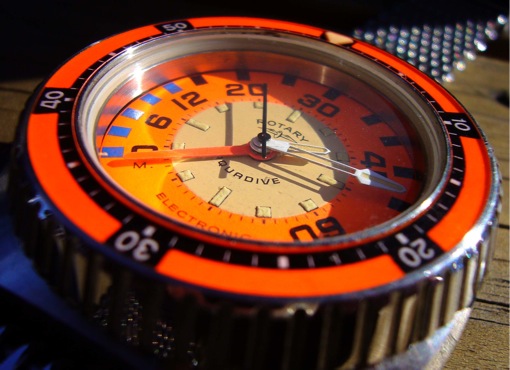

A number of watch companies used this movement and whilst rare today, in the 1960s they were seen as very modern for the time, especially when it is borne in mind that the quartz movement was still very much on the horizon at that time. Apart from their accuracy and there being no need to wind these movements, another desirable feature when looking at these movements today is that by using a balance, the second hand moves round the dial in the same manner as a normal mechanical watch.

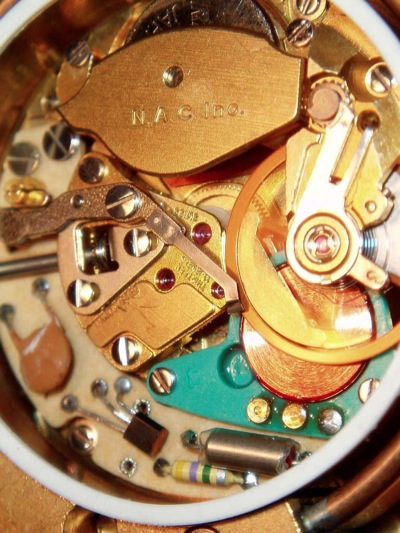

ESA 1954 ‘Dynatron’
Specifications:
12.5'''
13 rubies
Ø = 28.20mm
H = 5.55mm
f = 28800 A/h

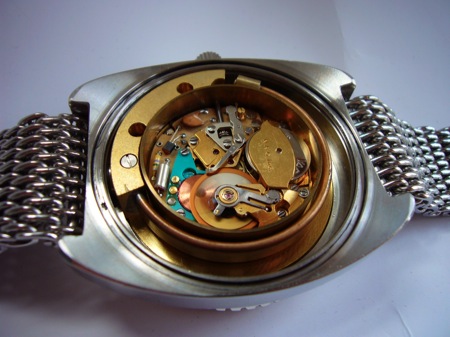

Back in the 1970’s, the ‘Dynatron’ movement was powered by a 1.35v Mercury battery that was said to be ‘good for 10,000 hours’. Today’s 1.5v Silver Oxide batteries work fine in these watches for most people. The modern replacement is a 344/350 and battery life in one of these watches is approx 12months, depending on condition of the movement.
To provide a hacking function the power to the movement is interrupted when the crown is pulled out, in addition a physical brake stops the balance so that when the crown is pushed back in the stored energy in the hairspring is released and restarts the balance immediately.

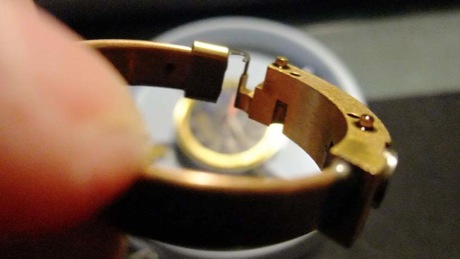

The gauge works in the following manner:
External water pressure acts upon a sealed inverted neoprene cup, this in turn transmits the pressure to the incompressible ‘Fryquel’ oil, which causes the bourdon tube to straighten. The movement of the tube is transmitted via a small hook to the patented rack and pinion mechanism, moving the gauge needle and thus indicating the measured depth.






Due to the age of these watches pure depth testing in water is not recommended, although some watchmakers who use positive pressure depth testers may be able to help. In our view, the only way to safely check the function of the gauge is to apply a gentle pressure to the membrane between the lugs using a blunt instrument whilst observing the depth pointer on the gauge. Beware when doing this as any disturbance on these old seals and parts can cause damage and DeskDivers takes no responsibility for any failures.

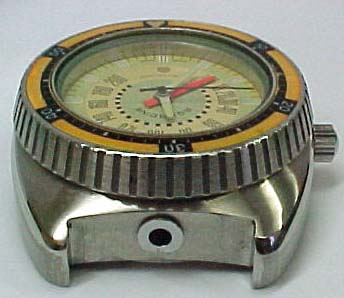

The crown is fitted to the left side of the case in what we today term a ‘Destro’ configuration. This design is used for reasons of wrist articulation, and is especially useful on large watches as it provides the diver with greater freedom in which to move their wrist than if the crown was located at 3 o’clock as in a normal watch and reduces the risk of damage or snagging. The crown is sealed with an o ring and screws down to keep the case watertight.
It is interesting that this watch is only rated to 10ATM (100m) when Aquadive produced other watches at the time that were rated to much deeper depths. Whilst 100m was more than enough for many of the professional divers of the day, the reason is perhaps more prosaic in that the range of the depth meter is only 60m and 10ATM gives a comfortable safety margin.

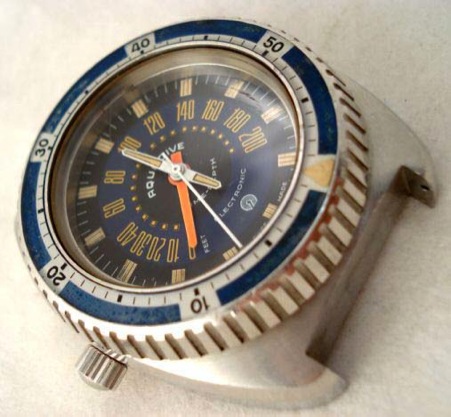


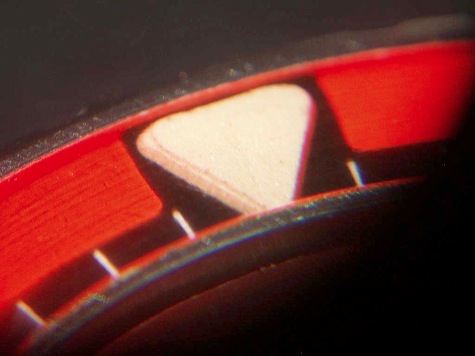

The dial design details differ between the versions, but generally are characterised by their colourful nature and good readability. The hands of the Aquadive models are shorter than their Rotary siblings, whose hands are longer and also have a useful cut out in the minute hand revealing the dial and pointers below. It is felt that the design of the hands used on the Aquadive models are somewhat of a failing, not only are they too short for such a large dialled watch, but also the solid minute hand can obscure the depth meter pointer, which could cause a degree of confusion not needed underwater. The hands are coated with tritium luminous paint, which after so many years now glows poorly, but often will have attained a lovely brown sugar colour and texture. The seconds hand was available in both long and short versions, and painted in either black or white. There does not appear to be any pattern with regard to either brand or dial colour for which hand would be fitted to any type of watch.

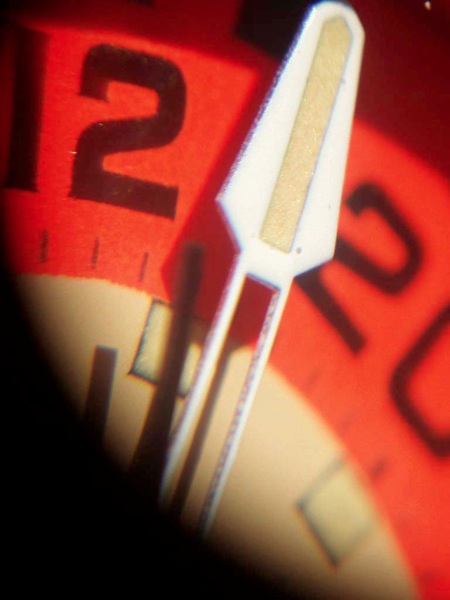


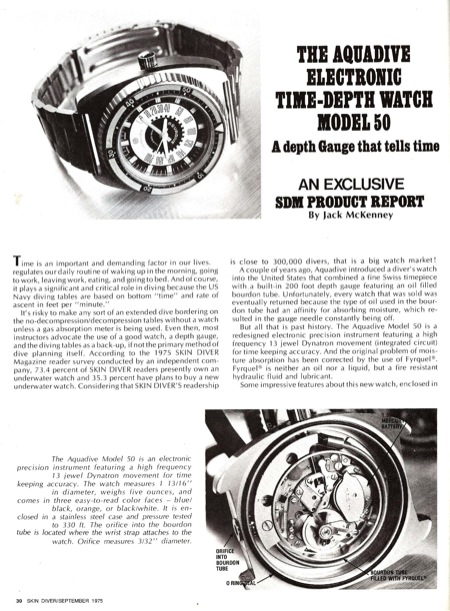

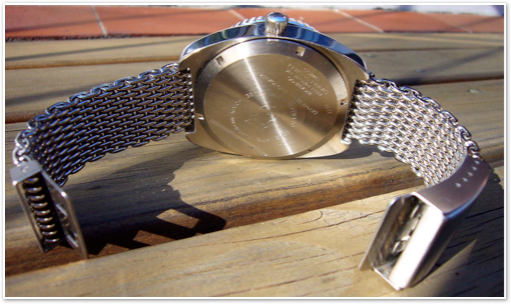

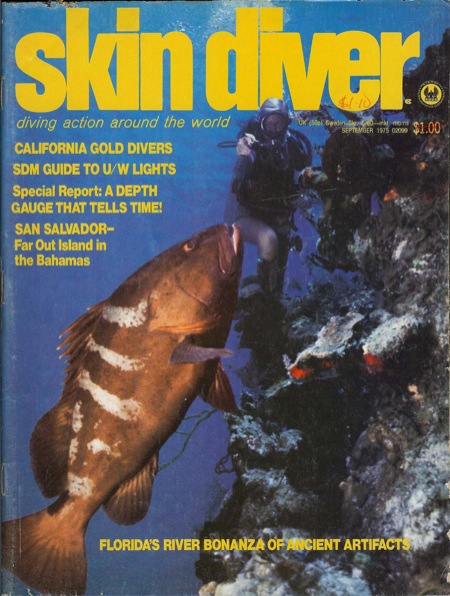








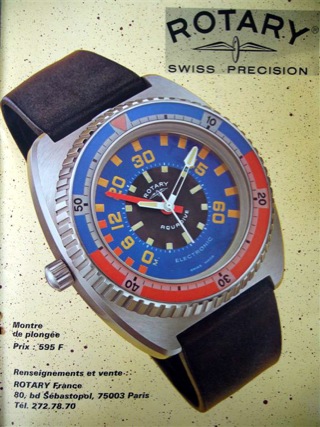





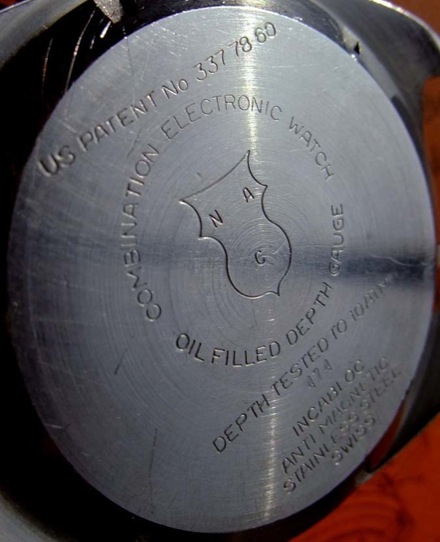


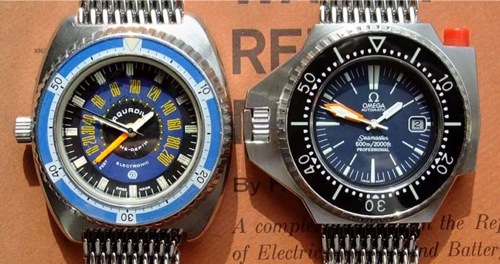













DeskDivers has yet to see a production version of this early dial design or a watch with the Favre Leuba style hand, this could be due to the timeframe needed to produce printed material back in the 70's, where often adverts and catalogues were often produced before a product reached final sign off and didn't reflect the actual product completely when it was launched. However, this could have been an early variation of this watch that has yet to surface on the market and if anyone has a watch with this design, please do contact us.
When launched in 1973 the Aquadive Model 50 was advertised as being approved and endorsed by Astronaut Scott Carpenter, who by this time was also a world famous Aquanaut after his SEALAB adventures. It cost $225 and was available with Grey, Orange or blue dials. The early publicity images show a different dial design which was said to use 3M's Scotchlite™ product (made up of reflective microscopic glass beads) to aid visibility underwater.
These early watch photos also feature a longer minute hand which appears similar to those used on the larger Favre Leuba dive watches, and its interesting that Aquadive chose not to continue to fit that hand set in production.
In 1975 Aquadive re-launched the watch (no doubt due to the previous year's hydraulic fluid problems). The re-launch was accompanied by a comprehensive and complimentary review in Skin Diver Magazine (already in its 24th year of publication), something of a media coup.

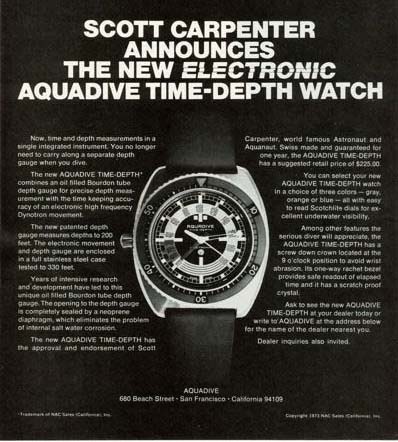




At that time the price had risen to $250 and the watch was available with dial colours of blue/black, orange or black/white.



Someco SA was established in 1966 in Neuchatel, Switzerland and have made watch dials for many of the major manufacturers over the years. They were a rare survivor of the rough times for the Swiss watch industry during the 1980s and still produce and hand finish watch dials today. A tidbit of trivia: Sameco SA is probably the only dial manufacturer to feature a model railway in the attic of its factory!

